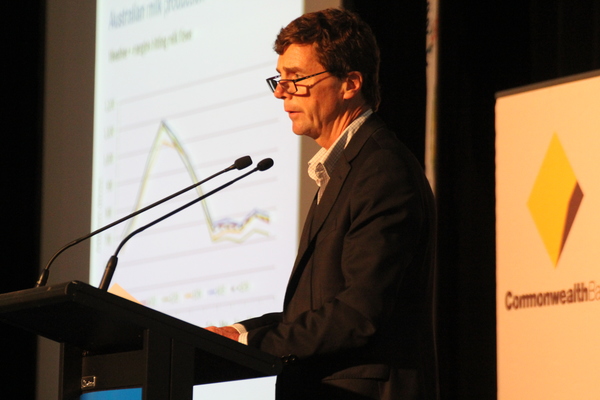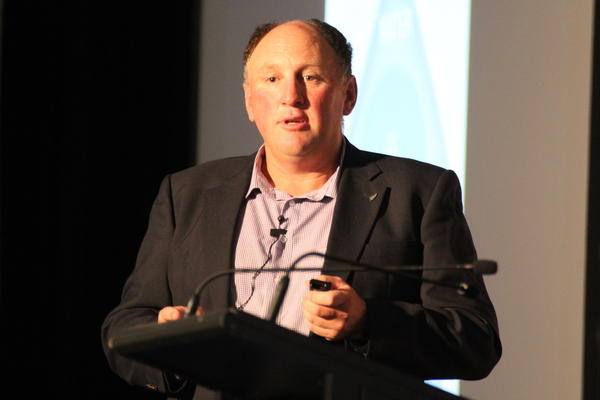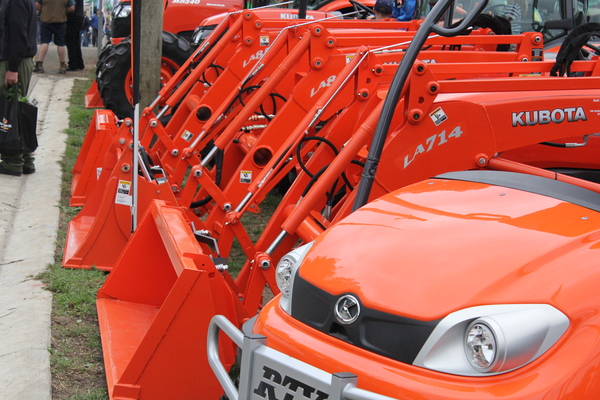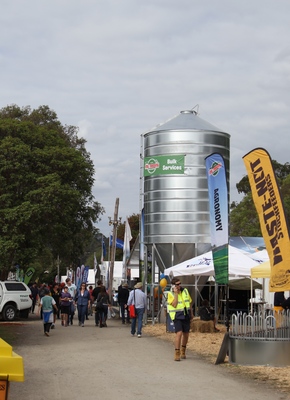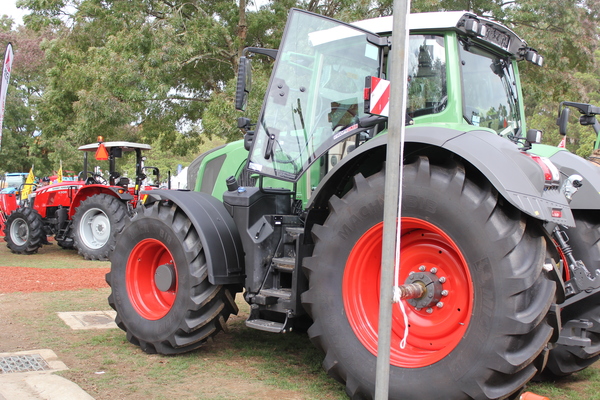THE dairy industry has been surrounded by talk of an impending ‘boom’ in recent times, but the farmers at Farm World at Lardner Park recently must be wondering when the talk ends and something a little more tangible begins.
Dairy Australia managing director Ian Halliday spoke to the room about the changes that had been occurring within the Australian dairy industry, and what was on its horizon in the coming years.
“Dairy on The Move is the theme and I think if you just look at the list of entries, exits, restructures and investments that’ve taken place over the last two or three years there has been an enormous amount of interest in dairy and an enormous amount of investment,” Ian said.
“We’ve seen investment of about $2-3 billion just in the past three to four years alone, and I think that level of investment is going to continue.
“Most of it is going to be post-farmgate but we have also recently seen quite a bit of investment going in pre-farmgate.
“There is an enormous amount of investment that has taken place and I’m sure will continue to take place, but one of the biggest challenges that we do see in front of us at the moment is how we get profitable milk volume to flow.”
Ian said the biggest challenge, in his mind, would be getting profitable milk volume to really capitalise on the investment that’s taking place.
“(But) with all that positive news about investment and desire for growth, we do have some challenges right now,” he said.
“As I travel all around Australia, I see some of the climatic challenges we’re experiencing. I don’t need to tell any of you here how dry it’s been in the past seven or eight months.
“As at the end of February, Gippsland is down about 2.7 per cent on volume versus the prior year.
“On a national basis, I’d have to say across most of south east Australia it’s been exceptionally dry – particularly across the southern parts of Victoria, up in the north of Victoria, South Australia, and also in Tasmania so at the end of February – nationally – we’re down about 0.7 per cent on volume. February alone was down about 4.9 per cent. Victoria, which represents about 65 per cent of the total milk produced across the country, is down nearly two per cent versus the prior year.”
Ian said the forecast for the full year this year was a reduction of about one to two per cent on the previous 12 months.
“It goes quite a deal in contrast to all the investment we’ve seen in the past two or three years – we’ve actually seen a reduction in milk volume this year, but it is understandable and it is about making sure – from a farmer’s perspective – that if we’re going to be producing milk it has to be profitable,” he said, adding how important it was to keep the topic of domestic demand on the agenda.
“Everyone talks about the growth and opportunities up in Asia, but about 66 per cent of what we produce is sold in the domestic market,” he said.
“It’s a terribly important market for us and a good point that I certainly would like to highlight is the fact that within most of the categories we operate, we’re still seeing growth and particularly in drinking milk.”
Ian said that flew in the face of the situation in other developed countries, such as the United States.
“In Australia, we’ve actually seen growth in drinking milk,” he said.
“It’s not through just chance.
“I think the coffee culture we have in this country has helped with this growth, and we’ve also been heavily involved in doing some international research about the benefits of dairy. I think the commentary you’re seeing now in the press, through health professionals, is starting to really change consumers’ attitudes about dairy – in fact it’s good for your health to be consuming more dairy.
“But the other message is that our domestic market is still critically important to us.
“If I was to reflect on New Zealand, one of the challenges it has is that 95 per cent of what they produce is sold on the international market so they become very exposed to what’s happening globally. But because we’ve got a strong domestic market, we have been a little bit cushioned.
“In 2015, the imports into China dropped from 2.4 million tonnes down to about two million tonnes as they tried to work through all that product they bought in 2013 and 2014. They were on the decline last year. Growth is starting to come back but it’s going to be moderate.
“The other big impact has been in Russia. Russia used to import over 600,000 tonnes of product. About two years ago, most could remember that the Russian government introduced a ban on the importation of a lot of products – including dairy. That 600,000 tonnes then had to go into other markets.”
Ben Smith, a New Zealand Northland dairy farmer, spoke on the Friday of the Farm World event about the opportunity to make the most of natural resources in order to be less reliant on dairy and, only dairy, as a primary means of income.
He spoke at length about the ‘Integrated Farming Solution’ which stemmed from water – from the perspective of many New Zealand dairy farmers – being both their biggest asset, and biggest enemy.
The solution works on a circular economy, where resources, products and waste of one aspect of farming become fuel for another. The cycle then keeps going.
“We’re fifth-generation dairy farmers in the north of New Zealand … so I wear the Kiwi logo and I wear the silver fern with pride,” he said, showing the room a series of stunning photographs of his property.
“We’re not as strongly-influenced as you (Australian farmers) by a lack of water. We can grow plenty of grass. But in 48 hours, we can go to this – 5600 hectares of land under water five metres deep.
“Have you ever known something to take three weeks to pump the water out? Have you ever known the struggle to feed your animals? I don’t need to talk to the dairy farmers in this room. They’re the people who live it and survive it every day.
“I know what it feels like when you’ve got brown dirt and nothing to feed your animals.
“I know what it feels like to have to take those happy pills to say that I can survive this because just like alcoholics to alcohol, as dairy farmers we’re addicted to farming. We’re addicted to our animals and we’re addicted to the passion of feeding people. When the animals are standing there moaning like anything because they can’t get to their pasture, you feel it every day.”
Ben described the Integrated Farming Solution as “a simple business plan”.
“You’ve got the dairy farm and milk production, and out of that we produce milk and an economy – everything like that,” he said.
“As a farmer, you’ve got regulations on how you produce your milk but you’re also getting more and more – particularly in New Zealand – regulation on the water that you produce. So, what did we come up with?
“We’ve come up with a multiplex system of bioenergy generation. Off 100 cows we can produce one cubic metre of methane gas a day. Off 3000 cows I can power 2000 homes. The by-product of that, of any gas production, is that I can produce heat.”
Ben also farms fish on his property, with an economic output that enables him to charge $100 per kilo for one product, with milk providing 63 cents per litre, and milk solids $12 per kilo.
“The system is pathways to a circular economy,” Ben said.
“What is waste in one input into your farm becomes a food source for the next. What I’m doing today is sharing my vision of a circular economy on-farm.
“You’ve got to know your neighbour because if he produces roses right next to you, you’re not going to be able to spray your thistles in the paddock beside him. But if he wants to produce fish, you can provide him with the fish food from your effluent. “Have you ever thought of it that way?
“You’ve got to test your ideas, and I can tell you that when you start to test your ideas you start to test your moral stance in life.
“At the moment we are losing four dairy farmers a week to suicide. Four a week. We’ve got a women’s dairy network that is working overtime to support these families because at the end of the day the people that are doing the support are mainly the wives and kids. This is the part of agriculture that nobody wants to talk about. You’ve been there – the farmers in the room can tell me of experiences like that, I’m sure. So, how do we make a difference? I’ve been privileged to be involved in setting up dairy farmers in China.
“The story is getting bigger – milk consumption in the world will continue to grow. Food consumption in the world will continue to grow. So what are we doing about it? We’ve got to educate our people, our young people, that dairy farming has a future.”

